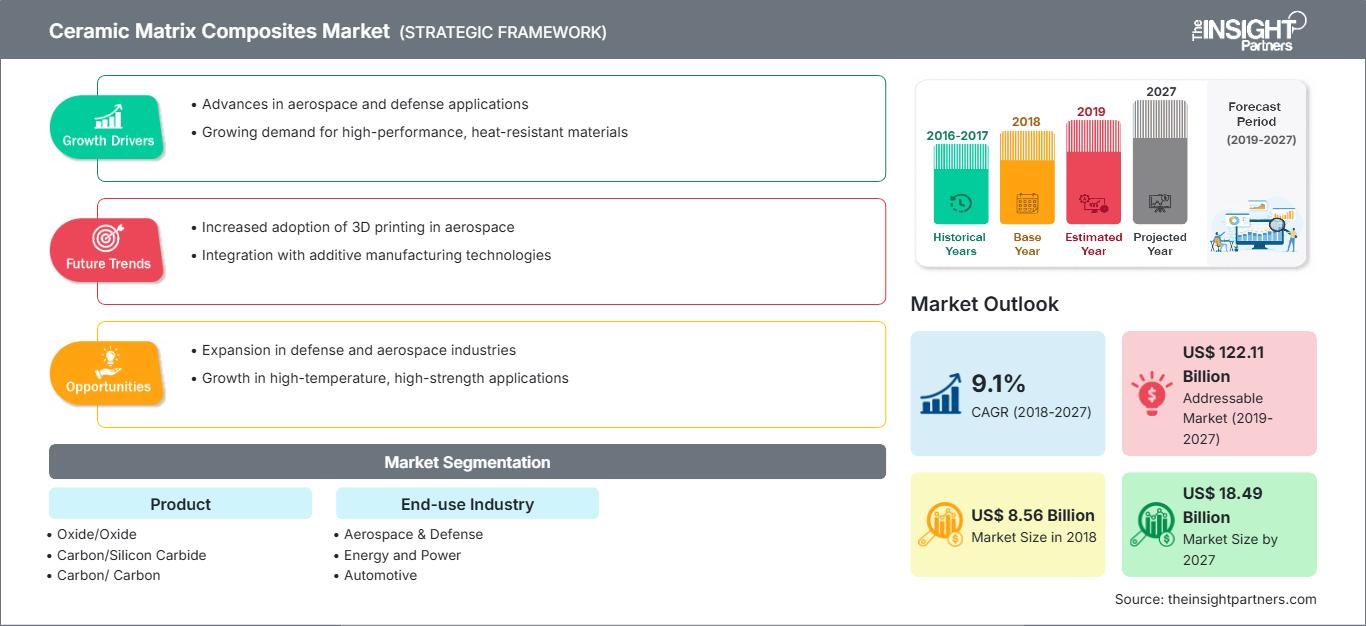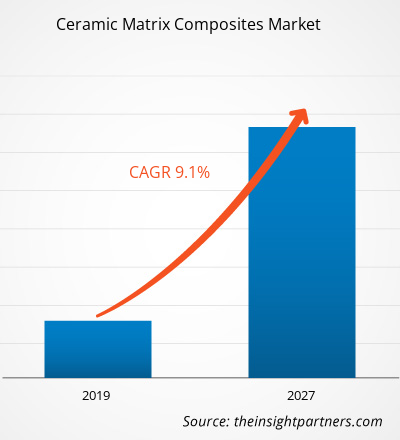[Rapporto di ricerca] Il mercato dei compositi a matrice ceramica ha rappresentato 8.560,0 milioni di dollari nel 2018 e si prevede che crescerà a un CAGR del 9,1% nel periodo di previsione 2019-2027, raggiungendo i 18.485,0 milioni di dollari entro il 2027.
ANALISI DI MERCATO
I compositi a matrice ceramica (CMC) si riferiscono a una classe di materiali avanzati che combinano fibre o particelle ceramiche con una matrice ceramica per creare un materiale composito ad alte prestazioni. Questi compositi sono progettati per sfruttare le proprietà desiderabili sia delle fibre/particelle di rinforzo che della matrice ceramica per ottenere una maggiore resistenza meccanica, stabilità termica e altre caratteristiche migliorate rispetto ai materiali ceramici tradizionali. Le proprietà meccaniche dei compositi a matrice ceramica, come l'elevata resistenza al calore e alla trazione, li rendono una componente importante dei settori automobilistico, della difesa e aerospaziale. Si prevede che l'aumento della base applicativa in vari settori finali offrirà opportunità di crescita per il mercato dei compositi a matrice ceramica.
FATTORI DI CRESCITA E SFIDE
La crescente domanda di compositi a matrice ceramica (CMC) nei settori emergenti deriva dalle loro proprietà uniche che si allineano ai requisiti di questi settori. Nel settore delle energie rinnovabili, i CMC trovano applicazione nelle turbine eoliche e negli impianti solari, dove la loro leggerezza contribuisce a migliorare l'efficienza energetica e a ridurre i costi. Inoltre, le prestazioni ad alta temperatura dei CMC li rendono adatti all'uso in impianti solari a concentrazione e sistemi geotermici. Nel settore dei veicoli elettrici, i CMC offrono soluzioni leggere e ad alta resistenza per componenti come involucri di batterie, alloggiamenti di motori e sistemi frenanti, contribuendo allo sviluppo di veicoli elettrici più efficienti e sostenibili. La versatilità dei CMC li posiziona come una scelta promettente in questi settori emergenti, trainando la crescita del mercato dei compositi a matrice ceramica.
Tuttavia, l'elevato costo dei compositi a matrice ceramica (CMC) rappresenta un freno significativo alla crescita del mercato dei compositi a matrice ceramica. I processi di produzione complessi e specializzati coinvolti nella produzione dei CMC, tra cui la produzione delle fibre, la preparazione della matrice e la fabbricazione del composito, contribuiscono a costi di produzione più elevati rispetto ai materiali tradizionali. Questo sovrapprezzo limita l'adozione diffusa dei CMC, in particolare nei settori che privilegiano l'economicità. L'elevato costo rappresenta inoltre una sfida per i produttori più piccoli o le aziende con risorse limitate, che potrebbero avere difficoltà a investire nelle attrezzature e nelle competenze necessarie per la produzione di CMC. Inoltre, la limitata scalabilità dei processi di produzione dei CMC ne limita ulteriormente la disponibilità in grandi quantità, rendendoli meno accessibili e convenienti per i potenziali utenti. Di conseguenza, l'elevato costo dei CMC costituisce un ostacolo alla crescita del mercato dei compositi a matrice ceramica.
Personalizza questo rapporto in base alle tue esigenze
Potrai personalizzare gratuitamente qualsiasi rapporto, comprese parti di questo rapporto, o analisi a livello di paese, pacchetto dati Excel, oltre a usufruire di grandi offerte e sconti per start-up e università
Mercato dei compositi a matrice ceramica: Approfondimenti strategici

-
Ottieni le principali tendenze chiave del mercato di questo rapporto.Questo campione GRATUITO includerà l'analisi dei dati, che vanno dalle tendenze di mercato alle stime e alle previsioni.
SEGMENTAZIONE E AMBITO DEL RAPPORTO
L'"Analisi del mercato globale dei compositi a matrice ceramica fino al 2027" è uno studio specializzato e approfondito con particolare attenzione alle tendenze e alle opportunità di crescita del mercato globale dei compositi a matrice ceramica. Il rapporto mira a fornire una panoramica del mercato globale dei compositi a matrice ceramica con una segmentazione dettagliata del mercato per prodotto, settore di utilizzo finale e area geografica. Il mercato globale dei compositi a matrice ceramica ha registrato una forte crescita nel recente passato e si prevede che questa tendenza continuerà durante il periodo di previsione. Il rapporto fornisce statistiche chiave sul consumo di compositi a matrice ceramica a livello mondiale, insieme alla loro domanda nelle principali regioni e paesi. Inoltre, il rapporto fornisce una valutazione qualitativa di vari fattori che influenzano l'andamento del mercato dei compositi a matrice ceramica nelle principali regioni e paesi. Il rapporto include anche un'analisi completa dei principali attori del mercato dei compositi a matrice ceramica e dei loro principali sviluppi strategici. Sono incluse anche diverse analisi sulle dinamiche di mercato per aiutare a identificare i principali fattori trainanti, le tendenze di mercato e le redditizie opportunità di mercato dei compositi a matrice ceramica che, a loro volta, aiuterebbero a identificare le principali fonti di reddito.
Inoltre, l'analisi dell'ecosistema e l'analisi delle cinque forze di Porter forniscono una visione a 360 gradi del mercato globale dei compositi a matrice ceramica, che aiuta a comprendere l'intera catena di fornitura e i vari fattori che influenzano la crescita del mercato.
ANALISI SEGMENTALE
Il mercato globale dei compositi a matrice ceramica è segmentato in base al prodotto e al settore di utilizzo finale. In base al prodotto, il mercato dei compositi a matrice ceramica è segmentato in ossidi/ossido, carburo di silicio/carburo di silicio, carbonio/carburo di silicio e carbonio/carbonio. In base al settore di utilizzo finale, il mercato dei compositi a matrice ceramica è classificato come aerospaziale e difesa, energia e potenza, automobilistico, industriale e altri.
In base al prodotto, il segmento ossidi/ossidi ha rappresentato una quota significativa del mercato dei compositi a matrice ceramica nel 2022. I compositi a matrice ceramica (CMC) ossidi/ossidi svolgono un ruolo significativo nel guidare la crescita del mercato. Questi CMC offrono vantaggi unici come un'eccellente stabilità termica, resistenza alle alte temperature e migliori proprietà meccaniche. Gli ossidi, come l'ossido di alluminio (Al2O3) e l'ossido di zirconio (ZrO2), fungono da matrice ceramica in questi compositi, mentre le fibre a base di ossidi, come le fibre di allumina, rinforzano la struttura. I CMC ossido/ossido trovano ampie applicazioni in settori come l'aerospaziale, la difesa e l'energia, dove le loro eccezionali proprietà termiche e la loro durata sono fondamentali. Sono utilizzati nelle sezioni calde dei motori a turbina a gas, nei rivestimenti barriera termica e nei componenti ad alta temperatura di aeromobili e nell'esplorazione spaziale. La crescente domanda di materiali ad alte prestazioni in grado di resistere a temperature estreme e ambienti difficili sta guidando l'adozione di CMC ossido/ossido, con conseguente espansione del mercato dei compositi a matrice ceramica e opportunità di crescita.
ANALISI REGIONALE
Il rapporto fornisce una panoramica dettagliata del mercato globale dei compositi a matrice ceramica in cinque regioni principali, ovvero Nord America, Europa, Asia-Pacifico (APAC), Medio Oriente e Africa (MEA) e America meridionale e centrale. La regione del Nord America ha dominato il mercato dei compositi a matrice ceramica, con un fatturato di oltre 4.500 milioni di dollari nel 2022. Il Nord America vanta una forte presenza di settori chiave che utilizzano ampiamente i CMC, come l'aerospaziale, la difesa e l'energia. Questi settori hanno una forte domanda di materiali avanzati con proprietà superiori, tra cui leggerezza, elevata resistenza e stabilità termica, che i CMC possono offrire. Si prevede che il mercato europeo dei compositi a matrice ceramica raggiungerà un fatturato di oltre 7.300 milioni di dollari nel 2028. L'industria dei compositi a matrice ceramica ha acquisito un ruolo significativo nell'economia europea, promuovendo crescita, innovazione e occupazione. I compositi a matrice ceramica sono strettamente correlati a diversi settori industriali, come la difesa, l'aerospaziale, l'energia e l'industria elettrica ed elettronica. Si prevede che il mercato dei compositi a matrice ceramica nell'area Asia-Pacifico crescerà a un CAGR significativo, superiore al 10%. I paesi della regione stanno assistendo a un aumento della popolazione e a una crescita dell'urbanizzazione, che offre ampie opportunità per i principali attori del mercato CMC.
SVILUPPI DEL SETTORE E OPPORTUNITÀ FUTURE
Partnership, acquisizioni e lanci di nuovi prodotti sono state le principali strategie adottate dagli attori che operano nel mercato globale dei compositi a matrice ceramica.
- Nel 2019, SGL Carbon ha esteso il suo contratto con Elbe Flugzeugwerke per la fornitura di tessuti in fibra di carbonio impregnati da utilizzare nei pannelli del pavimento della cabina dell'Airbus A350 fino alla fine del 2020.
- Nell'aprile 2023, SGL Carbon ha annunciato una nuova partnership con Lancer Systems per sviluppare compositi a matrice ceramica da utilizzare nei sistemi di protezione termica.
- Nel gennaio 2023, Rolls-Royce ha firmato un Memorandum d'intesa con l'Università di Sheffield nel Regno Unito per collaborare allo sviluppo di nuovi materiali compositi a matrice ceramica.
Approfondimenti regionali sul mercato dei compositi a matrice ceramica
Le tendenze regionali e i fattori che influenzano il mercato dei compositi a matrice ceramica durante il periodo di previsione sono stati ampiamente spiegati dagli analisti di The Insight Partners. Questa sezione illustra anche i segmenti e la geografia del mercato dei compositi a matrice ceramica in Nord America, Europa, Asia-Pacifico, Medio Oriente e Africa, America meridionale e centrale.
Ambito del rapporto di mercato sui compositi a matrice ceramica
| Attributo del rapporto | Dettagli |
|---|---|
| Dimensioni del mercato in 2018 | US$ 8.56 Billion |
| Dimensioni del mercato per 2027 | US$ 18.49 Billion |
| CAGR globale (2018 - 2027) | 9.1% |
| Dati storici | 2016-2017 |
| Periodo di previsione | 2019-2027 |
| Segmenti coperti |
By Prodotto
|
| Regioni e paesi coperti |
Nord America
|
| Leader di mercato e profili aziendali chiave |
|
Densità degli attori del mercato dei compositi a matrice ceramica: comprendere il suo impatto sulle dinamiche aziendali
Il mercato dei compositi a matrice ceramica è in rapida crescita, trainato dalla crescente domanda degli utenti finali, dovuta a fattori quali l'evoluzione delle preferenze dei consumatori, i progressi tecnologici e una maggiore consapevolezza dei vantaggi del prodotto. Con l'aumento della domanda, le aziende stanno ampliando la propria offerta, innovando per soddisfare le esigenze dei consumatori e sfruttando le tendenze emergenti, alimentando ulteriormente la crescita del mercato.

- Ottieni il Mercato dei compositi a matrice ceramica Panoramica dei principali attori chiave
IMPATTO DEL COVID
La pandemia di COVID-19 ha avuto un impatto significativo sul mercato dei compositi a matrice ceramica (CMC), causando interruzioni e ostacolando la crescita del mercato. La pandemia ha portato a una diffusa incertezza economica, a interruzioni della catena di approvvigionamento e a una riduzione delle attività industriali in diversi settori. Molti settori utilizzatori finali di CMC, come l'aerospaziale, l'automotive e l'energia, hanno dovuto affrontare significative battute d'arresto, tra cui interruzioni della produzione, ritardi nei progetti e riduzione degli investimenti. Le restrizioni ai viaggi e al commercio hanno anche influenzato la domanda di CMC nei mercati globali. Inoltre, i vincoli finanziari a cui sono sottoposte le aziende e l'attenzione alle misure di riduzione dei costi hanno portato a una riduzione delle spese in conto capitale e a un approccio cauto nell'adozione di materiali avanzati come i CMC. Sebbene si preveda una graduale ripresa del mercato con la riapertura delle economie e la ripresa delle attività industriali, la pandemia di COVID-19 ha certamente ostacolato la traiettoria di crescita del mercato dei CMC nel breve termine.
PAESAGGIO COMPETITIVO E AZIENDE CHIAVE
Alcuni dei principali attori che operano nel mercato dei compositi a matrice ceramica includono COI Ceramics, Inc.; General Electric Company; Lancer Systems; SGL Carbon; Rolls-Royce Plc; CoorsTek, Inc.; Applied Thin Films Inc.; Ultramet; CFCCARBON CO, LTD; e Matech, tra gli altri.
- Analisi storica (2 anni), anno base, previsione (7 anni) con CAGR
- Analisi PEST e SWOT
- Valore/volume delle dimensioni del mercato - Globale, Regionale, Nazionale
- Industria e panorama competitivo
- Set di dati Excel
Report recenti
Testimonianze
Motivo dell'acquisto
- Processo decisionale informato
- Comprensione delle dinamiche di mercato
- Analisi competitiva
- Analisi dei clienti
- Previsioni di mercato
- Mitigazione del rischio
- Pianificazione strategica
- Giustificazione degli investimenti
- Identificazione dei mercati emergenti
- Miglioramento delle strategie di marketing
- Aumento dell'efficienza operativa
- Allineamento alle tendenze normative






















 Ottieni un campione gratuito per - Mercato dei compositi a matrice ceramica
Ottieni un campione gratuito per - Mercato dei compositi a matrice ceramica